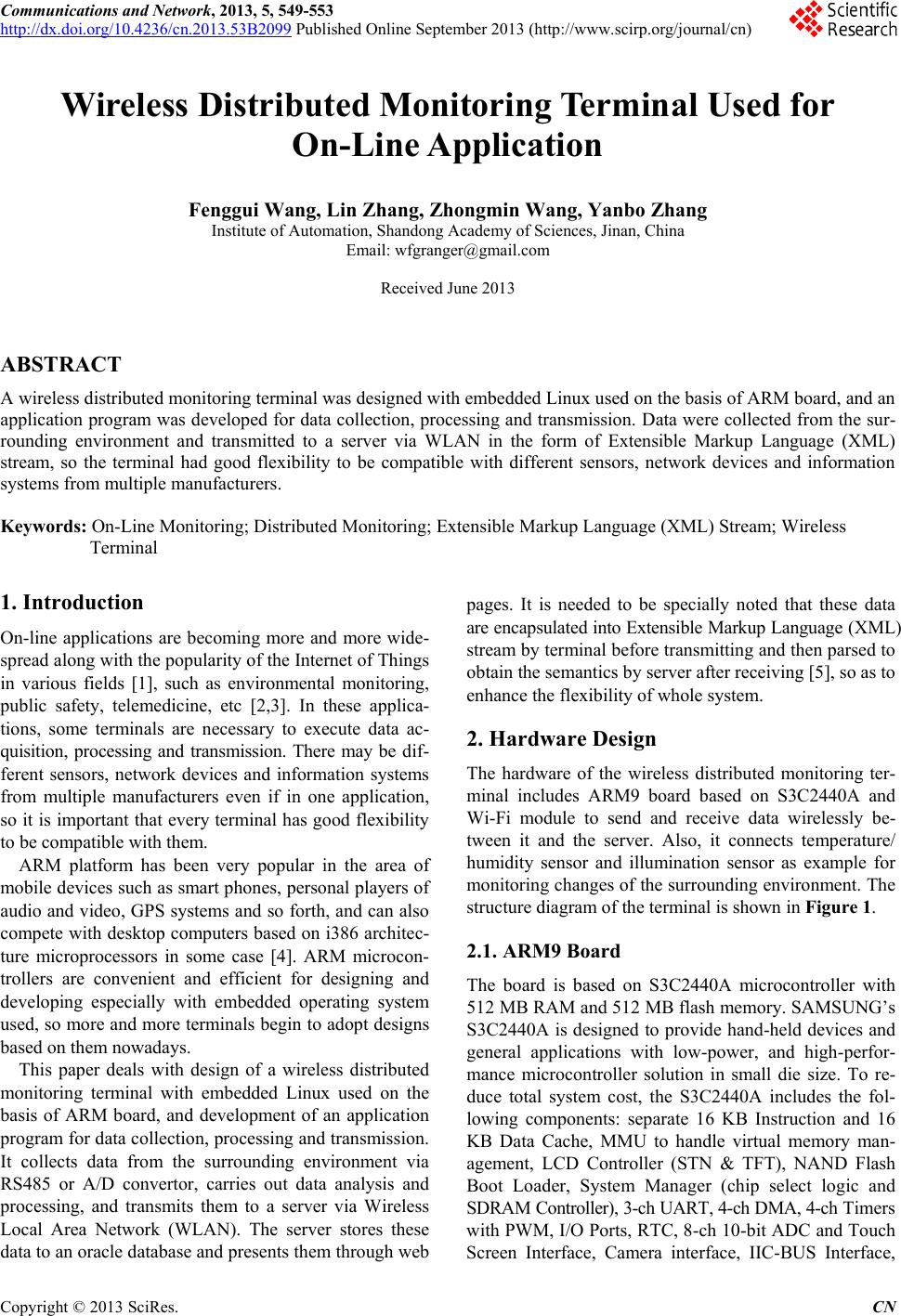
Communications and Network, 2013, 5, 549-553
http://dx.doi.org/10.4236/cn.2013.53B2099 Published Online September 2013 (http://www.scirp.org/journal/cn)
Copyright © 2013 SciRes. CN
Wireless Distributed Monitoring Terminal Used for
On-Line Application
Fenggui Wang, Lin Zhang, Zhongmin Wang, Yanbo Zhang
Institute of Automation, Shandong Academy of Sciences, Jinan, China
Email: wfgranger@gmail.com
Received June 2013
ABSTRACT
A wireless distributed monitoring terminal was designed with embedded Linux used on the basis of ARM board, and an
application program was developed for data collection, processing and transmission. Data were collected from the sur-
rounding environment and transmitted to a server via WLAN in the form of Extensible Markup Language (XML)
stream, so the terminal had good flexibility to be compatible with different sensors, network devices and information
systems from multiple manufacturers.
Keywords: On-Line Monitoring; Distributed Monitoring; Extensible Markup Language (XML) Stream; Wireless
Terminal
1. Introduction
On-line applications are becoming more and more wide-
spread along with the popularity of the Internet of Things
in various fields [1], such as environmental monitoring,
public safety, telemedicine, etc [2,3]. In these applica-
tions, some terminals are necessary to execute data ac-
quisition, processing and transmission. There may be dif-
ferent sensors, network devices and information systems
from multiple manufacturers even if in one application,
so it is important that every terminal has good flexibility
to be compatible with them.
ARM platform has been very popular in the area of
mobile devices such as smart phones, personal players of
audio and video, GPS systems and so forth, and can also
compete with desktop computers based on i386 architec-
ture microprocessors in some case [4]. ARM microcon-
trollers are convenient and efficient for designing and
developing especially with embedded operating system
used, so more and more terminals begin to adopt designs
based on them nowadays.
This paper deals with design of a wireless distributed
monitoring terminal with embedded Linux used on the
basis of ARM board, and development of an application
program for data collection, processing and transmission.
It collects data from the surrounding environment via
RS485 or A/D convertor, carries out data analysis and
processing, and transmits them to a server via Wireless
Local Area Network (WLAN). The server stores these
data to an oracle database and presents them through web
pages. It is needed to be specially noted that these data
are encapsulated into Extensible Markup Language (XML)
stream by terminal before transmitting and then parsed to
obtain the semantics by server after receiving [5], so as to
enhance the flexibility of whole system.
2. Hardware Design
The hardware of the wireless distributed monitoring ter-
minal includes ARM9 board based on S3C2440A and
Wi-Fi module to send and receive data wirelessly be-
tween it and the server. Also, it connects temperature/
humidity sensor and illumination sensor as example for
monitoring changes of the surrounding environment. The
structure diagram of the terminal is shown in Figure 1.
2.1. ARM9 Board
The board is based on S3C2440A microcontroller with
512 MB RAM and 512 MB flash memory. SAMSUNG’s
S3C2440A is designed to provide hand-held devices and
general applications with low-power, and high-perfor-
mance microcontroller solution in small die size. To re-
duce total system cost, the S3C2440A includes the fol-
lowing components: separate 16 KB Instruction and 16
KB Data Cache, MMU to handle virtual memory man-
agement, LCD Controller (STN & TFT), NAND Flash
Boot Loader, System Manager (chip select logic and
SDRA M Con tro ll er), 3-ch UART, 4-ch DMA, 4-ch Timers
with PWM, I/O Ports, RTC, 8-ch 10-bit ADC and Touch
Screen Interface, Camera interface, IIC-BUS Interface,